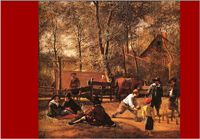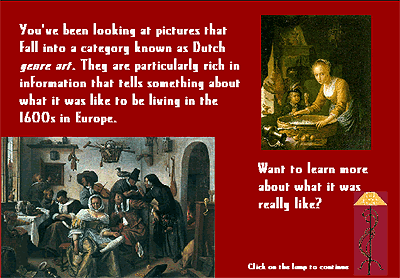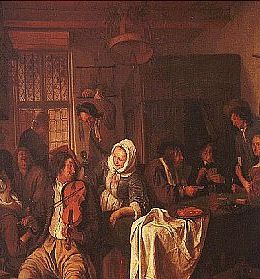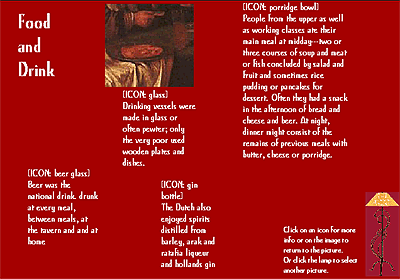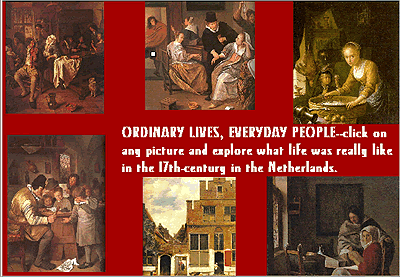
What Was It Like to Live in the Netherlands in the 17th Century? An interactive multimedia prototype based on Dutch genre art designed for use in a museum environment I first became interested in the idea that paintings--in addition to being visually pleasing and emotionally stimulating--could also serve as a source of historical information back in the early 1980s. I was then assistant editor of History News magazine (a publication designed for the folks who run the history museums in this country) and wrote a short feature on the subject: "Aesthetics Aside: How to Find Historical Information in Works of Art." Over the intervening years, I have grown increasingly interested in the kinds of connections one can make to create a composite picture of what the past was really like. With advances in technology, it is becoming increasingly easier to tie together information that crosses discipline boundaries. History is not just a series of dates, after all; art is more than pretty pictures on a wall. If we open our vision to arenas of human experience that we never thought of as "history," we may well enrich our understanding of the whole human past--and ourselves. To do so means understanding that history is not simply a sequence of events--history is experience. I am particularly interested in the interrelationship of music and art and history, and for this project attempted to create a project that would intertwine the three in a multimedia format that encouraged the learner to explore connections. Click HERE for a shockwave version of the prototype. Or see below for a description with selected screen shots from the Authorware application.
This prototype focuses on genre art because it is so rich
with historical information. It might include (but not be limited to) artists
such as Breughel, Gerrit Dou, Jan Van Eyck, Frans Hals, Adrian Ostade, Jan
Steen, Gerard Terborch, and Vermeer, as well as lesser Dutch and Flemish artists
working in the 1600s. But it could easily be adapted for many other specific
time frames; it could also be structured to provide information about many
countries in a particular window of time by choosing artists from six different
areas of the world. It might also be more art-focused, less history-based,
so that if a learner was particularly interested in, say, Vermeer, the info
pages would link to other works, a biography, even a map of the other locations
of all Vermeer works in the world.
Learners will be able to explore paintings in a new way and make connections between art and history as well as music and other fields. They might choose to explore one painting or all six, depending on their time and interest. Additional links would allow them to follow up on special interests and it might be possible to even have them take part of the information with them by either printing out selected pages or sending them to a personal e-mail address. (Because of the potential licensing problems and technical difficulties this area would need to be investigated thoroughly.) The final program would have a total of about 250 screens, heavily graphic intensive. More than a third (or about 90) would include audio or video clips. If you're interested in a more complete discussion of the prototype,
please see the full Dutch paper.
©TLC Productions 1999. All rights reserved. |
|||||||||||||||||||||||||||||||||||||



